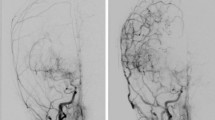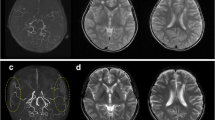Abstract
Background
There are no previously published reports regarding the epidemiology and characteristics of moyamoya disease or syndrome in Ireland.
Aims
To examine patient demographics, mode of presentation and the outcomes of extracranial-intracranial bypass surgery in the treatment of moyamoya disease and syndrome in Ireland.
Methods
All patients with moyamoya disease and syndrome referred to the National Neurosurgical Centre during January 2012–January 2019 were identified through a prospective database. Demographics, clinical presentation, radiological findings, surgical procedures, postoperative complications and any strokes during follow-up were recorded.
Results
Twenty-one patients were identified. Sixteen underwent surgery. Median age at diagnosis was 19 years. Fifteen were female. Mode of presentation was ischaemic stroke in nine, haemodynamic TIAs in eight, haemorrhage in three and incidental in one. Sixteen patients had Moyamoya disease, whereas five patients had moyamoya syndrome. Surgery was performed on 19 hemispheres in 16 patients. The surgical procedures consisted of ten direct (STA-MCA) bypasses, five indirect bypasses and four multiple burr holes. Postoperative complications included ischaemic stroke in one patient and subdural haematoma in one patient. The median follow-up period in the surgical group was 52 months; there was one new stroke during this period. Two patients required further revascularisation following recurrent TIAs. One patient died during follow-up secondary to tumour progression associated with neurofibromatosis type 1.
Conclusions
Moyamoya is rare but occurs in Caucasians in Ireland. It most commonly presents with ischaemic symptoms. Surgical intervention in the form of direct and indirect bypass is an effective treatment in the majority of cases.






Similar content being viewed by others
References
Takeuchi KS, K. (1957) Hypoplasia of bilateral internal carotid arteries. Brain Nerve 9:37–43
Suzuki J, Takaku A (1969) Cerebrovascular “moyamoya” disease. Disease showing abnormal net-like vessels in base of brain. Arch Neurol 20(3):288–299
Wakai K, Tamakoshi A, Ikezaki K, Fukui M, Kawamura T, Aoki R, Kojima M, Lin Y, Ohno Y (1997) Epidemiological features of moyamoya disease in Japan: findings from a nationwide survey. Clin Neurol Neurosurg 99(Suppl 2):S1–S5
Baba T, Houkin K, Kuroda S (2008) Novel epidemiological features of moyamoya disease. J Neurol Neurosurg Psychiatry 79(8):900–904. https://doi.org/10.1136/jnnp.2007.130666
Scott RM, Smith ER (2009) Moyamoya disease and moyamoya syndrome. N Engl J Med 360(12):1226–1237. https://doi.org/10.1056/NEJMra0804622
Acker G, Goerdes S, Schmiedek P, Czabanka M, Vajkoczy P (2016) Characterization of clinical and radiological features of quasi-moyamoya disease among European Caucasians including surgical treatment and outcome. Cerebrovasc Dis 42(5–6):464–475. https://doi.org/10.1159/000448812
Huang S, Guo ZN, Shi M, Yang Y, Rao M (2017) Etiology and pathogenesis of Moyamoya Disease: an update on disease prevalence. Int J Stroke 12(3):246–253. https://doi.org/10.1177/1747493017694393
Kamada F, Aoki Y, Narisawa A, Abe Y, Komatsuzaki S, Kikuchi A, Kanno J, Niihori T, Ono M, Ishii N, Owada Y, Fujimura M, Mashimo Y, Suzuki Y, Hata A, Tsuchiya S, Tominaga T, Matsubara Y, Kure S (2011) A genome-wide association study identifies RNF213 as the first Moyamoya disease gene. J Hum Genet 56(1):34–40. https://doi.org/10.1038/jhg.2010.132
Cho WS, Chung YS, Kim JE, Jeon JP, Son YJ, Bang JS, Kang HS, Sohn CH, Oh CW (2015) The natural clinical course of hemodynamically stable adult moyamoya disease. J Neurosurg 122(1):82–89. https://doi.org/10.3171/2014.9.jns132281
Gross BA, Du R (2013) The natural history of moyamoya in a North American adult cohort. J Clin Neurosci 20(1):44–48. https://doi.org/10.1016/j.jocn.2012.08.002
Kang S, Liu X, Zhang D, Wang R, Zhang Y, Zhang Q, Yang W, Zhao JZ (2019) Natural course of moyamoya disease in patients with prior hemorrhagic stroke. Stroke 50(5):1060–1066. https://doi.org/10.1161/strokeaha.118.022771
Research Committee on the Pathology and Treatment of Spontaneous Occlusion of the Circle of Willis. Health Labour Sciences Research Grant for Research on Measures for Infractable Diseases (2012) Guidelines for diagnosis and treatment of moyamoya disease (spontaneous occlusion of the circle of Willis). Neurol Med Chir (Tokyo) 52(5):245–266
Bang JS, Kwon OK, Kim JE, Kang HS, Park H, Cho SY, Oh CW (2012) Quantitative angiographic comparison with the OSIRIS program between the direct and indirect revascularization modalities in adult moyamoya disease. Neurosurgery 70(3):625–632; discussion 632-623. https://doi.org/10.1227/NEU.0b013e3182333c47
Jiang H, Ni W, Xu B, Lei Y, Tian Y, Xu F, Gu Y, Mao Y (2014) Outcome in adult patients with hemorrhagic moyamoya disease after combined extracranial-intracranial bypass. J Neurosurg 121(5):1048–1055. https://doi.org/10.3171/2014.7.jns132434
Kim T, Oh CW, Kwon OK, Hwang G, Kim JE, Kang HS, Cho WS, Bang JS (2016) Stroke prevention by direct revascularization for patients with adult-onset moyamoya disease presenting with ischemia. J Neurosurg 124(6):1788–1793. https://doi.org/10.3171/2015.6.jns151105
Kuroda S, Houkin K, Ishikawa T, Nakayama N, Iwasaki Y (2010) Novel bypass surgery for moyamoya disease using pericranial flap: its impacts on cerebral hemodynamics and long-term outcome. Neurosurgery 66(6):1093–1101; discussion 1101. https://doi.org/10.1227/01.neu.0000369606.00861.91
Miyamoto S, Yoshimoto T, Hashimoto N, Okada Y, Tsuji I, Tominaga T, Nakagawara J, Takahashi JC (2014) Effects of extracranial-intracranial bypass for patients with hemorrhagic moyamoya disease: results of the Japan Adult Moyamoya trial. Stroke 45(5):1415–1421. https://doi.org/10.1161/strokeaha.113.004386
Hong JM, Lee SJ, Lee JS, Choi MH, Lee SE, Choi JW, Lim YC (2018) Feasibility of multiple burr hole with erythropoietin in acute moyamoya patients. Stroke 49(5):1290–1295. https://doi.org/10.1161/strokeaha.117.020566
Cho WS, Kim JE, Kim CH, Ban SP, Kang HS, Son YJ, Bang JS, Sohn CH, Paeng JC, Oh CW (2014) Long-term outcomes after combined revascularization surgery in adult moyamoya disease. Stroke 45(10):3025–3031. https://doi.org/10.1161/strokeaha.114.005624
Bao XY, Duan L, Yang WZ, Li DS, Sun WJ, Zhang ZS, Zong R, Han C (2015) Clinical features, surgical treatment, and long-term outcome in pediatric patients with moyamoya disease in China. Cerebrovasc Dis 39(2):75–81. https://doi.org/10.1159/000369524
Central Statistics Office (2019) StatBank Census Populations. Central Statistics Office. https://statbank.cso.ie/px/pxeirestat/Statire/SelectVarVal/Define.asp?Maintable=EY029&Planguage=0. Accessed 13/01/19
Central Statistics Office (2019) StatBank Estimated Populations. Central Statistics Office. https://statbank.cso.ie/px/pxeirestat/Statire/SelectVarVal/Define.asp?maintable=PEA21&PLanguage=0. Accessed 13/01/19
Donaghy R (1967) Patch and bypass in microangeional surgery. Microvascular Surgery St Louis: CV Mosby:75–86
Yasargil MG (1969) Anastomosis between the superficial temporal artery and a branch of the middle cerebral artery. Microsurg Appl Neurosurg:105–115
Chang S, G. S (2000) Superficial temporal artery to middle cerebral artery anastomosis. Tech Neurosurg 6 (2):86–100
Karasawa J, Kikuchi H, Furuse S, Sakaki T, Yoshida Y (1977) A surgical treatment of “moyamoya” disease “encephalo-myo synangiosis”. Neurol Med Chir (Tokyo) 17(1 Pt 1):29–37
Kinugasa K, Mandai S, Kamata I, Sugiu K, Ohmoto T (1993) Surgical treatment of moyamoya disease: operative technique for encephalo-duro-arterio-myo-synangiosis, its follow-up, clinical results, and angiograms. Neurosurgery 32(4):527–531
Sainte-Rose C, Oliveira R, Puget S, Beni-Adani L, Boddaert N, Thorne J, Wray A, Zerah M, Bourgeois M (2006) Multiple bur hole surgery for the treatment of moyamoya disease in children. J Neurosurg 105(6 Suppl):437–443. https://doi.org/10.3171/ped.2006.105.6.437
Matsushima Y, Fukai N, Tanaka K, Tsuruoka S, Inaba Y, Aoyagi M, Ohno K (1981) A new surgical treatment of moyamoya disease in children: a preliminary report. Surg Neurol 15(4):313–320
Takahashi JC, Miyamoto S (2010) Moyamoya disease: recent progress and outlook. Neurol Med Chir (Tokyo) 50(9):824–832
Hever P, Alamri A, Tolias C (2015) Moyamoya angiopathy - is there a Western phenotype? Br J Neurosurg 29(6):765–771. https://doi.org/10.3109/02688697.2015.1096902
Hori S, Kashiwazaki D, Yamamoto S, Acker G, Czabanka M, Akioka N, Kuwayama N, Vajkoczy P, Kuroda S (2018) Impact of interethnic difference of collateral angioarchitectures on prevalence of hemorrhagic stroke in moyamoya disease. Neurosurgery. 85:134–146. https://doi.org/10.1093/neuros/nyy236
Yamamoto S, Hori S, Kashiwazaki D, Akioka N, Kuwayama N, Kuroda S (2018) Longitudinal anterior-to-posterior shift of collateral channels in patients with moyamoya disease: an implication for its hemorrhagic onset. J Neurosurg:1–7. https://doi.org/10.3171/2017.9.jns172231
Kuriyama S, Kusaka Y, Fujimura M, Wakai K, Tamakoshi A, Hashimoto S, Tsuji I, Inaba Y, Yoshimoto T (2008) Prevalence and clinicoepidemiological features of moyamoya disease in Japan: findings from a nationwide epidemiological survey. Stroke 39(1):42–47. https://doi.org/10.1161/strokeaha.107.490714
Goto Y, Yonekawa Y (1992) Worldwide distribution of moyamoya disease. Neurol Med Chir (Tokyo) 32(12):883–886
Acker G, Goerdes S, Schneider UC, Schmiedek P, Czabanka M, Vajkoczy P (2015) Distinct clinical and radiographic characteristics of moyamoya disease amongst European Caucasians. Eur J Neurol 22(6):1012–1017. https://doi.org/10.1111/ene.12702 Epub 2015 Apr 6
Kraemer M, Heienbrok W, Berlit P (2008) Moyamoya disease in Europeans. Stroke 39(12):3193–3200. https://doi.org/10.1161/strokeaha.107.513408
Saarela M, Mustanoja S, Pekkola J, Tyni T, Hernesniemi J, Kivipelto L, Tatlisumak T (2017) Moyamoya vasculopathy - patient demographics and characteristics in the Finnish population. Int J Stroke 12(1):90–95. https://doi.org/10.1177/1747493016669847
Khan N, Schuknecht B, Boltshauser E, Capone A, Buck A, Imhof HG, Yonekawa Y (2003) Moyamoya disease and Moyamoya syndrome: experience in Europe; choice of revascularisation procedures. Acta Neurochir 145(12):1061–1071; discussion 1071. https://doi.org/10.1007/s00701-003-0148-5
Liu J. ZW, Wang W. (2010) Moyamoya disease in China. In: Cho BK. TT (ed) Moyamoya disease update. Springer, Tokyo, pp 370–373. https://doi.org/10.1007/978-4-431-99703-0_51
Birkeland P, Lauritsen J (2018) Incidence of moyamoya disease in Denmark: a population-based register study. Acta Neurochir Suppl 129:91–93. https://doi.org/10.1007/978-3-319-73739-3_13
Kleinloog R, Regli L, Rinkel GJ, Klijn CJ (2012) Regional differences in incidence and patient characteristics of moyamoya disease: a systematic review. J Neurol Neurosurg Psychiatry 83(5):531–536. https://doi.org/10.1136/jnnp-2011-301387
Han DH, Kwon OK, Byun BJ, Choi BY, Choi CW, Choi JU, Choi SG, Doh JO, Han JW, Jung S, Kang SD, Kim DJ, Kim HI, Kim HD, Kim MC, Kim SC, Kim Y, Kwun BD, Lee BG, Lim YJ, Moon JG, Park HS, Shin MS, Song JH, Suk JS, Yim MB (2000) A co-operative study: clinical characteristics of 334 Korean patients with moyamoya disease treated at neurosurgical institutes (1976-1994). The Korean Society for Cerebrovascular Disease. Acta Neurochir 142(11):1263–1273 discussion 1273-1264
Ikezaki K, Han DH, Kawano T, Kinukawa N, Fukui M (1997) A clinical comparison of definite moyamoya disease between South Korea and Japan. Stroke 28(12):2513–2517
Gross BA, Du R (2013) Adult moyamoya after revascularization. Acta Neurochir 155(2):247–254. https://doi.org/10.1007/s00701-012-1545-4
Oliveira RS, Amato MC, Simao GN, Abud DG, Avidago EB, Specian CM, Machado HR (2009) Effect of multiple cranial burr hole surgery on prevention of recurrent ischemic attacks in children with moyamoya disease. Neuropediatrics 40(6):260–264. https://doi.org/10.1055/s-0030-1249069
Funaki T, Takahashi JC, Takagi Y, Yoshida K, Araki Y, Kikuchi T, Kataoka H, Iihara K, Sano N, Miyamoto S (2014) Incidence of late cerebrovascular events after direct bypass among children with moyamoya disease: a descriptive longitudinal study at a single center. Acta Neurochir 156(3):551–559; discussion 559. https://doi.org/10.1007/s00701-013-1975-7
Kalani MY, Rangel-Castilla L, Ramey W, Nakaji P, Albuquerque FC, McDougall CG, Spetzler RF, Zabramski JM (2015) Indications and results of direct cerebral revascularization in the modern era. World Neurosurg 83(3):345–350. https://doi.org/10.1016/j.wneu.2014.10.013
Thines L, Petyt G, Aguettaz P, Bodenant M, Himpens FX, Lenci H, Henon H, Gauthier C, Hossein-Foucher C, Cordonnier C, Lejeune JP (2015) Surgical management of Moyamoya disease and syndrome: current concepts and personal experience. Rev Neurol (Paris) 171(1):31–44. https://doi.org/10.1016/j.neurol.2014.08.007
Acknowledgments
The authors would like to thank Ms. Deirdre Nolan and Ms. Paula Corr from the audit and research department, Beaumont Hospital, for helping with chart reviews and data collection.
Author information
Authors and Affiliations
Corresponding author
Ethics declarations
Conflict of interest
DJH McCabe’s research group has received grant funding from the Trinity College Dublin Innovation Bursary, the Meath Foundation, Ireland, The Vascular Neurology Research Foundation, Ireland and an unrestricted educational grant from SINNOWA Medical Science & Technology Co., China. None of the above charities or funding bodies had any influence on the conduct of this study, or had any influence on the decision to submit the final manuscript for publication.
Ethical approval
This study was approved by the institutional audit board of Beaumont Hospital, Dublin, Ireland.
Additional information
Publisher’s note
Springer Nature remains neutral with regard to jurisdictional claims in published maps and institutional affiliations.
Rights and permissions
About this article
Cite this article
Doherty, R.J., Caird, J., Crimmins, D. et al. Moyamoya disease and moyamoya syndrome in Ireland: patient demographics, mode of presentation and outcomes of EC-IC bypass surgery. Ir J Med Sci 190, 335–344 (2021). https://doi.org/10.1007/s11845-020-02280-w
Received:
Accepted:
Published:
Issue Date:
DOI: https://doi.org/10.1007/s11845-020-02280-w




